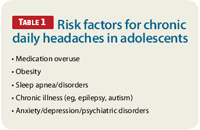Managing chronic daily headaches
A 14-year-old girl comes to your office complaining of having a headache every day for the last 3 months.

Key Points
Case 1: A 14-year-old girl comes to your office complaining of having a headache every day for the past 3 months. Her mother is very concerned because the girl has missed the last 4 weeks of school and now may not be able to graduate from junior high school. The patient says that her headaches are "all over" and that she has been taking ibuprofen daily without relief. The mother asks you for a note to excuse the child from school.
Case 2: A 12-year-old boy presents with daily headaches, which he says he has had since fifth grade. He tells you that he feels as if 2 rubber bands are wrapped around his head. He does not take any medications. He wakes up in the morning and goes to sleep with a headache but is never awoken by pain. His mother and grandmother both had migraines. The family asks for a prescription to make the headaches go away right now.
These are common scenarios that pediatricians and other primary care providers face almost daily. Chronic daily headache (CDH) is such a frustrating, common complaint among adolescents that medical providers often find themselves in a quandary about what to do and might simply refer the child elsewhere. However, with some patience and a few clinical pearls, management of headache in these teens can be easy, highly successful, and even rewarding. This article will help guide the reader to identify red flags, orchestrate simple pharmacologic and nonpharmacologic treatments, and manage CDH in the adolescent patient.

Regardless of the specified name, the management strategies for CDH remain the same. Start with a history and physical appropriate to the adolescent with headaches. After assessing potential risk factors (Table 1), set specific goals with tangible outcomes, and engage active participation from the teen. Success almost always coincides with moving the locus of control for headache management from the parent or pediatrician to the teenager.